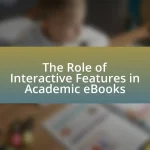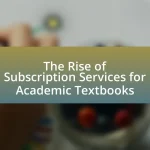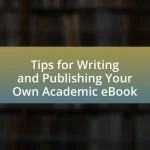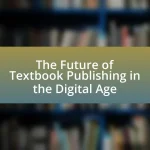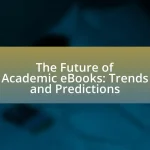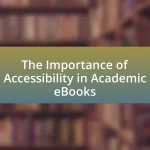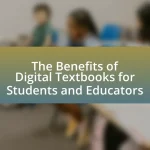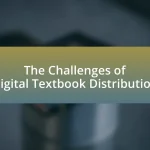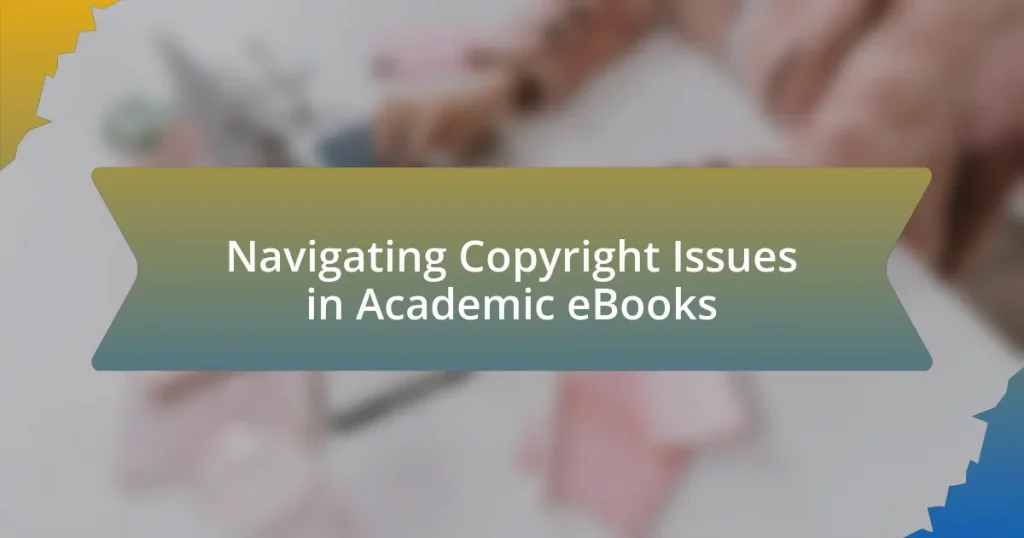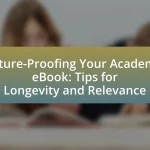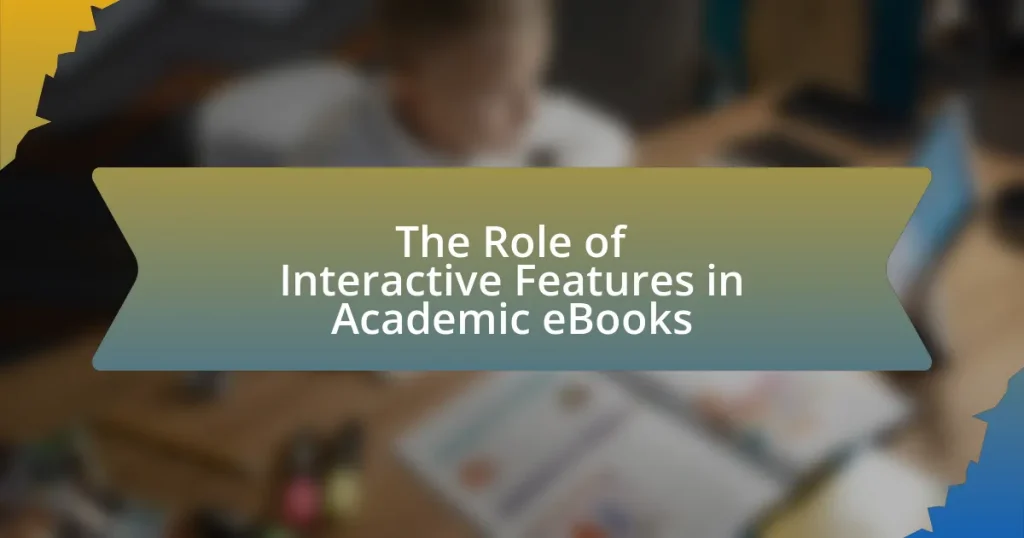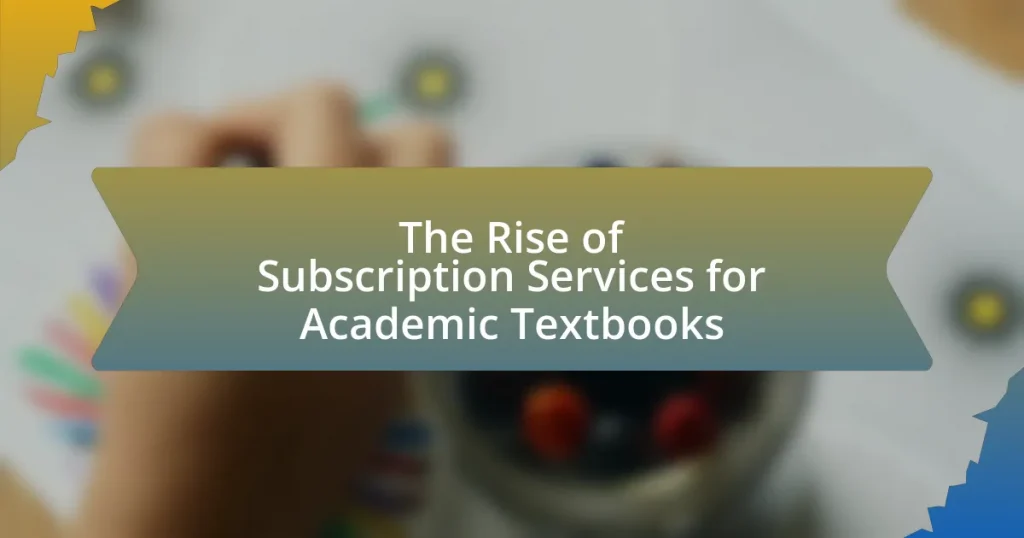The article focuses on navigating copyright issues in academic eBooks, highlighting the unauthorized reproduction, distribution, and use of copyrighted materials that can infringe on the rights of authors and publishers. It outlines how copyright laws apply to academic eBooks, the key components relevant to them, and the differences in copyright laws across countries. The article emphasizes the importance of understanding copyright for academic authors, the risks of ignoring copyright issues, and strategies for protecting rights when publishing eBooks. Additionally, it discusses the challenges faced by academic institutions regarding copyright compliance and the role of fair use and public domain in academic contexts. Finally, it addresses future trends in copyright, the impact of technology on enforcement, and best practices for authors and institutions to enhance copyright understanding.

What are Copyright Issues in Academic eBooks?
Copyright issues in academic eBooks primarily involve the unauthorized reproduction, distribution, and use of copyrighted materials. These issues arise when academic institutions, students, or researchers use eBooks without proper licensing or permissions, potentially infringing on the rights of authors and publishers. For instance, many academic eBooks contain proprietary content that is protected under copyright law, which prohibits copying or sharing without consent. According to the U.S. Copyright Office, copyright infringement can lead to legal consequences, including monetary damages and injunctions against further use.
How do copyright laws apply to academic eBooks?
Copyright laws apply to academic eBooks by granting authors and publishers exclusive rights to reproduce, distribute, and display their works. These laws protect the intellectual property of the creators, ensuring that they receive recognition and financial compensation for their contributions. For instance, under the U.S. Copyright Act, academic eBooks are automatically protected upon creation, meaning that unauthorized copying or distribution can lead to legal consequences. Additionally, fair use provisions may allow limited use of copyrighted material for educational purposes, but this is subject to specific criteria, such as the purpose of use and the amount of content used.
What are the key components of copyright law relevant to eBooks?
The key components of copyright law relevant to eBooks include the protection of original works, the rights of authors and publishers, and the limitations on use such as fair use. Copyright law grants authors exclusive rights to reproduce, distribute, and display their works, which applies to eBooks as they are considered literary works. Additionally, the Digital Millennium Copyright Act (DMCA) addresses the protection of digital content, making it illegal to circumvent digital rights management (DRM) technologies. Fair use provisions allow limited use of copyrighted material without permission, which is particularly relevant in academic contexts for purposes such as criticism, comment, or scholarship. These components ensure that creators are compensated for their work while also providing guidelines for the use of eBooks in educational settings.
How do copyright laws differ between countries for academic eBooks?
Copyright laws for academic eBooks vary significantly between countries, primarily due to differences in legal frameworks, duration of protection, and enforcement mechanisms. For instance, the United States follows the Copyright Act of 1976, which grants authors exclusive rights for the life of the author plus 70 years, while the European Union adheres to the EU Copyright Directive, which also provides similar protection but emphasizes the moral rights of authors. In contrast, countries like India operate under the Copyright Act of 1957, which has different provisions regarding fair use and educational exceptions. These variations can affect how academic eBooks are published, shared, and accessed globally, leading to complexities in compliance for authors and institutions.
Why is understanding copyright important for academic authors?
Understanding copyright is crucial for academic authors because it protects their intellectual property rights and ensures they receive proper credit for their work. Copyright laws grant authors exclusive rights to reproduce, distribute, and display their original works, which is essential for maintaining academic integrity and preventing plagiarism. Additionally, knowledge of copyright helps authors navigate licensing agreements and fair use policies, allowing them to utilize existing works legally while contributing to the scholarly community. For instance, the U.S. Copyright Act of 1976 provides a framework that academic authors must understand to avoid legal disputes and maximize the impact of their research.
What risks do authors face if they ignore copyright issues?
Authors face significant legal and financial risks if they ignore copyright issues. These risks include potential lawsuits from copyright holders, which can result in costly legal fees and damages. For instance, the U.S. Copyright Act allows for statutory damages ranging from $750 to $30,000 per work infringed, and up to $150,000 for willful infringement. Additionally, authors may face loss of credibility and professional reputation if found to be infringing on others’ copyrights, which can hinder future publishing opportunities. Ignoring copyright can also lead to the removal of their work from platforms and loss of access to their audience, further impacting their career and income.
How can authors protect their rights when publishing eBooks?
Authors can protect their rights when publishing eBooks by registering their works with the U.S. Copyright Office, which provides legal recognition and the ability to enforce rights against infringement. Copyright registration establishes ownership and grants authors the exclusive right to reproduce, distribute, and display their work. Additionally, authors should include clear licensing terms in their eBooks, specifying how their work can be used by others, and consider using digital rights management (DRM) tools to prevent unauthorized copying and distribution. These measures are supported by the Copyright Act of 1976, which outlines the rights of authors and the importance of registration for legal protection.
What are common copyright challenges faced by academic institutions?
Academic institutions commonly face challenges related to copyright infringement, fair use interpretation, and licensing agreements. These challenges arise as institutions often utilize copyrighted materials for teaching and research, leading to potential violations if proper permissions are not obtained. For instance, the ambiguity surrounding fair use can result in disputes over whether specific uses of copyrighted works, such as excerpts in course materials, qualify as permissible. Additionally, institutions may struggle with negotiating licensing agreements that are both financially viable and legally compliant, particularly when dealing with digital content like eBooks. According to a study by the Association of Research Libraries, 70% of academic libraries reported difficulties in securing appropriate licenses for electronic resources, highlighting the prevalence of these copyright challenges.
How do institutions navigate licensing agreements for eBooks?
Institutions navigate licensing agreements for eBooks by carefully assessing their needs, understanding the terms of the agreements, and ensuring compliance with copyright laws. They typically begin by evaluating the specific eBook titles required for their curriculum or research, followed by reviewing licensing options offered by publishers, which may include single-user, multi-user, or site-wide licenses. Institutions also negotiate terms that align with their budget and usage requirements, often seeking to maximize access while minimizing costs.
For instance, many academic libraries utilize consortia to leverage collective bargaining power, allowing them to negotiate better terms and pricing for eBook licenses. Additionally, institutions must stay informed about copyright regulations and licensing restrictions to avoid potential legal issues, ensuring that their use of eBooks adheres to the agreed-upon terms. This approach not only facilitates access to necessary resources but also protects the institution from copyright infringement.
What role do fair use and public domain play in academic eBooks?
Fair use and public domain are crucial in academic eBooks as they allow for the incorporation of copyrighted materials without permission under certain conditions and enable the use of works that are no longer under copyright protection, respectively. Fair use permits limited use of copyrighted content for purposes such as criticism, comment, news reporting, teaching, scholarship, or research, which is essential for academic discourse and the dissemination of knowledge. For instance, the U.S. Copyright Act outlines four factors to determine fair use, including the purpose of use and the amount used, which helps educators and researchers utilize existing works while respecting copyright laws. Public domain, on the other hand, includes works that are free for use by anyone, such as texts published before 1923 or those for which copyright has expired, providing a rich resource for academic eBooks. This access to public domain materials enhances the availability of scholarly resources and supports the creation of new knowledge.
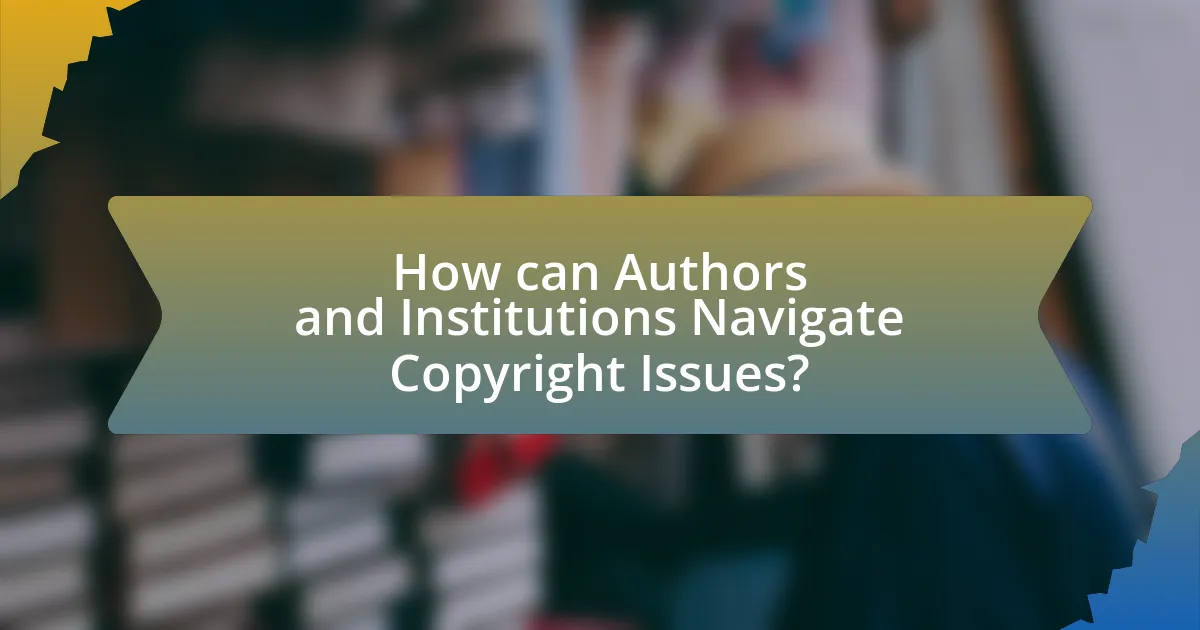
How can Authors and Institutions Navigate Copyright Issues?
Authors and institutions can navigate copyright issues by understanding copyright laws, utilizing Creative Commons licenses, and seeking permissions for third-party content. Copyright laws protect original works, and familiarity with these laws enables authors and institutions to ensure compliance and avoid infringement. Creative Commons licenses provide a flexible range of protections and freedoms for authors, allowing them to specify how their works can be used by others. Additionally, obtaining permissions for any third-party materials used in academic eBooks is crucial, as failure to do so can lead to legal disputes. These strategies collectively help authors and institutions manage copyright effectively in the context of academic publishing.
What strategies can authors use to ensure compliance with copyright laws?
Authors can ensure compliance with copyright laws by obtaining necessary permissions for any third-party content used in their works. This includes securing licenses for images, text, or data that are not original, as well as adhering to fair use guidelines, which allow limited use of copyrighted material without permission under specific circumstances. Additionally, authors should familiarize themselves with copyright registration processes to protect their own works, ensuring they understand the scope of their rights. According to the U.S. Copyright Office, registering a work provides legal advantages, including the ability to sue for infringement and eligibility for statutory damages. By following these strategies, authors can navigate copyright issues effectively in their academic eBooks.
How can authors effectively use Creative Commons licenses?
Authors can effectively use Creative Commons licenses by selecting the appropriate license that aligns with their distribution goals and the level of permissions they wish to grant to users. For instance, a Creative Commons Attribution license allows others to share and adapt the work as long as they credit the author, which can enhance visibility and reach. Additionally, authors should clearly communicate the chosen license on their work to inform users of their rights and obligations, ensuring compliance and fostering a culture of sharing. According to the Creative Commons organization, over 1.4 billion works are licensed under Creative Commons, demonstrating its widespread adoption and effectiveness in promoting open access and collaboration in academic publishing.
What steps should authors take to seek permission for copyrighted materials?
Authors should follow a systematic process to seek permission for copyrighted materials. First, they must identify the specific materials they wish to use and determine the copyright holder, which can often be found in the publication details or through a copyright database. Next, authors should draft a formal request for permission, clearly stating the intended use, the scope of the material, and the duration of use. This request should be sent to the copyright holder via email or through a designated permission request form, if available.
To reinforce the validity of this process, it is essential to note that many publishers and copyright holders have established guidelines for permission requests, which can streamline the process. Additionally, the U.S. Copyright Office emphasizes the importance of obtaining permission to avoid infringement, highlighting that unauthorized use can lead to legal consequences.
How can institutions support authors in navigating copyright issues?
Institutions can support authors in navigating copyright issues by providing comprehensive resources and training on copyright law and best practices. These resources can include workshops, online courses, and access to legal experts who specialize in intellectual property. For example, universities often have copyright offices that offer guidance on fair use, licensing agreements, and the implications of self-publishing. Additionally, institutions can create clear policies that outline the rights of authors regarding their works, ensuring that authors understand their ownership and the potential for collaboration with publishers. By fostering an environment of awareness and education, institutions empower authors to make informed decisions about their intellectual property, ultimately enhancing their ability to navigate complex copyright landscapes effectively.
What resources are available for copyright education in academic settings?
Resources available for copyright education in academic settings include online courses, workshops, and institutional guidelines. Many universities offer copyright training sessions through their libraries or legal departments, which provide essential information on copyright laws and fair use. Additionally, organizations like the Association of Research Libraries and the American Library Association provide comprehensive resources, including webinars and publications, to educate faculty and students about copyright issues. These resources are designed to enhance understanding of copyright in the context of academic eBooks and other scholarly materials.
How can institutions create policies that protect both authors and copyright holders?
Institutions can create policies that protect both authors and copyright holders by implementing clear guidelines that balance the rights and responsibilities of each party. These policies should include provisions for fair use, ensuring that authors retain certain rights while allowing copyright holders to maintain control over the distribution and reproduction of their works. For example, institutions can adopt licensing agreements that specify how academic eBooks can be used, shared, and modified, thereby safeguarding the interests of both authors and copyright holders. Additionally, institutions can provide training and resources on copyright law to educate authors about their rights and the implications of copyright infringement, which can foster a collaborative environment that respects intellectual property.
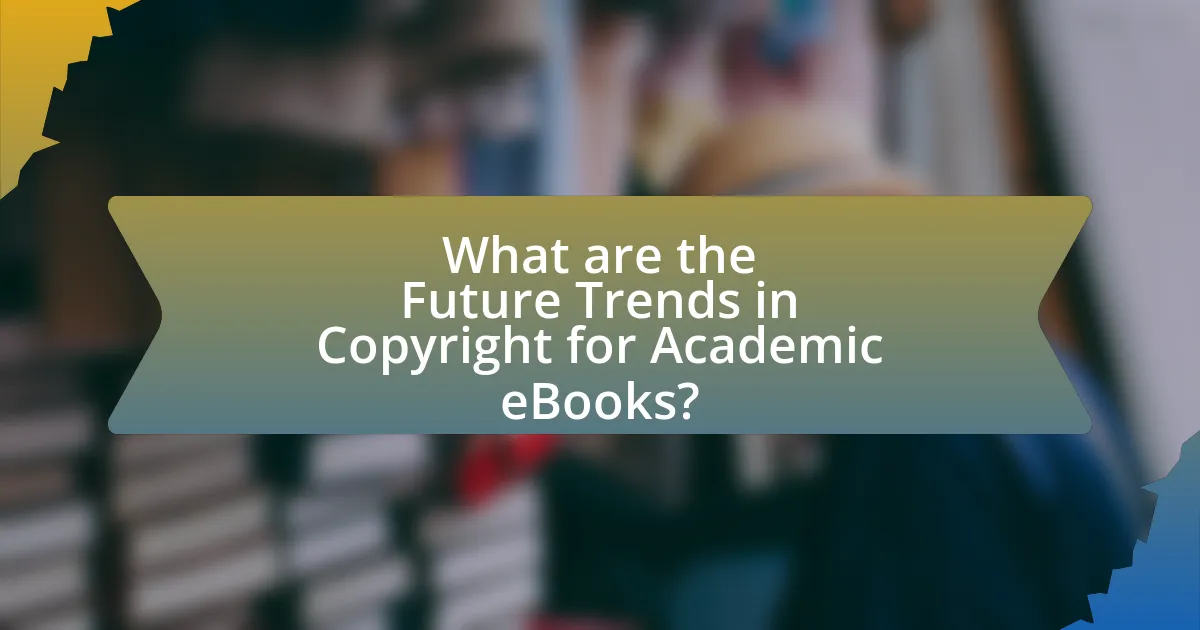
What are the Future Trends in Copyright for Academic eBooks?
Future trends in copyright for academic eBooks include increased adoption of open access models, enhanced digital rights management (DRM) technologies, and evolving licensing agreements. Open access is gaining traction as institutions and funding bodies push for wider dissemination of research, leading to more eBooks being published under Creative Commons licenses. Enhanced DRM technologies are being developed to protect intellectual property while allowing for flexible access, ensuring that authors and publishers can control how their works are used. Additionally, licensing agreements are becoming more complex, with institutions negotiating terms that balance access and copyright protection, reflecting the changing landscape of academic publishing. These trends are supported by the growing demand for accessible educational resources and the need for sustainable revenue models in the digital age.
How is technology impacting copyright issues in academic publishing?
Technology is significantly impacting copyright issues in academic publishing by facilitating easier distribution and access to scholarly works, which raises concerns about unauthorized use and reproduction. Digital platforms enable rapid sharing of research, but they also complicate the enforcement of copyright laws, as traditional mechanisms struggle to keep pace with the speed of digital dissemination. For instance, the rise of open-access models challenges conventional copyright frameworks, prompting debates over authors’ rights and the sustainability of publishing practices. Additionally, tools like plagiarism detection software and digital rights management systems are being developed to help protect intellectual property, yet they also introduce new complexities in how copyright is understood and applied in the academic context.
What role do digital rights management (DRM) systems play in eBooks?
Digital rights management (DRM) systems play a crucial role in eBooks by protecting copyright and controlling access to digital content. These systems prevent unauthorized copying, sharing, and distribution of eBooks, ensuring that authors and publishers retain control over their intellectual property. For instance, DRM can limit the number of devices on which an eBook can be accessed or restrict the ability to print or copy text. According to a report by the International Federation of Library Associations and Institutions, DRM is essential for maintaining the economic viability of digital publishing, as it helps to combat piracy and ensures that creators are compensated for their work.
How are emerging technologies changing the landscape of copyright enforcement?
Emerging technologies are significantly transforming copyright enforcement by enhancing monitoring capabilities and automating infringement detection. Technologies such as blockchain provide transparent tracking of ownership and usage rights, while artificial intelligence algorithms can analyze vast amounts of data to identify unauthorized reproductions of copyrighted material. For instance, AI-driven tools can scan online platforms to detect and flag instances of copyright violations in real-time, thereby streamlining the enforcement process. Additionally, digital rights management (DRM) systems are evolving to offer more robust protection against unauthorized access and distribution of academic eBooks, ensuring that copyright holders can better control their intellectual property. These advancements collectively contribute to a more efficient and effective framework for enforcing copyright in the digital age.
What best practices should authors and institutions adopt moving forward?
Authors and institutions should adopt clear copyright policies and ensure proper licensing for academic eBooks. Establishing transparent guidelines helps authors understand their rights and responsibilities, while institutions can protect their intellectual property. For instance, the Association of American Publishers emphasizes the importance of using Creative Commons licenses to facilitate sharing while maintaining copyright protections. Additionally, training sessions on copyright law can empower authors to navigate complex legal landscapes effectively, as highlighted by the Copyright Clearance Center’s resources. Implementing these practices fosters a culture of respect for intellectual property and enhances collaboration in academic publishing.
How can collaboration between authors and institutions enhance copyright understanding?
Collaboration between authors and institutions enhances copyright understanding by facilitating knowledge sharing and resource access. When authors work closely with institutions, they can gain insights into copyright laws, institutional policies, and best practices for managing intellectual property. For instance, institutions often provide training sessions and workshops on copyright issues, which can help authors navigate complex legal frameworks. Additionally, collaborative projects may involve legal experts who can clarify copyright implications specific to academic eBooks, ensuring that authors are aware of their rights and responsibilities. This partnership ultimately leads to a more informed academic community, reducing the risk of copyright infringement and promoting ethical publishing practices.
What are the key takeaways for navigating copyright in academic eBooks?
Key takeaways for navigating copyright in academic eBooks include understanding the distinction between copyright and fair use, recognizing the importance of licensing agreements, and being aware of the specific rights granted to authors and publishers. Copyright protects the original expression of ideas, while fair use allows limited use without permission under certain conditions, such as for educational purposes. Licensing agreements dictate how eBooks can be used, shared, or modified, and it is crucial for users to review these terms to avoid infringement. Additionally, authors typically retain certain rights, such as the ability to share their work in specific contexts, which can vary based on the publisher’s policies. Understanding these elements is essential for compliance and effective use of academic eBooks.
